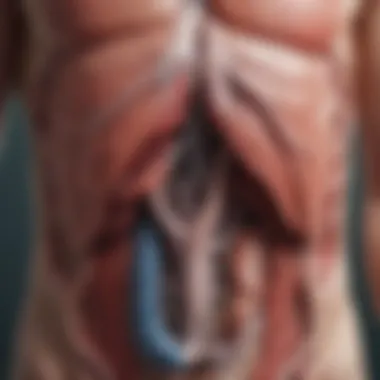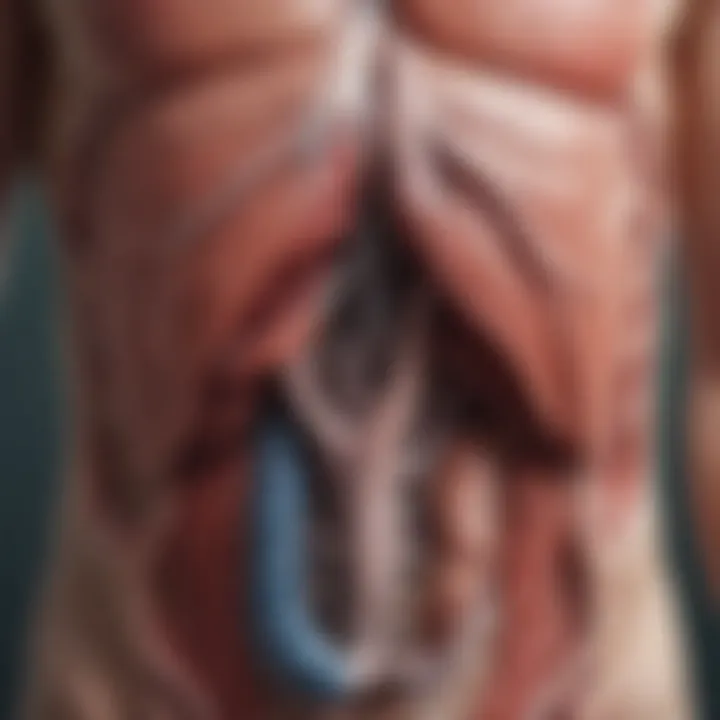Understanding Liver Pain: Causes, Symptoms, Management


Intro
Pain in the liver is a significant health concern that can arise from various factors. The liver, as one of the vital organs in the human body, plays an essential role in metabolism, detoxification, and synthesis of important proteins. Understanding the causes and symptoms related to liver pain is crucial for timely diagnosis and effective management.
This piece provides a detailed inquiry into the anatomical and physiological aspects of the liver. It covers common conditions that may induce pain, including hepatitis, liver cirrhosis, fatty liver disease, and liver tumors. The discussion will also touch on the accompanying symptoms, diagnostic methods, and treatment options available.
Comprehending the intricacies behind liver pain not only aids in recognizing the potential complications arising from these conditions but also highlights the importance of preventive strategies and lifestyle changes.
"Awareness and early intervention can significantly improve liver health outcomes."
As we explore these aspects, readers will gain insights that are pertinent for both personal and professional domains of health management.
Prelims to Liver Pain
Liver pain is a significant medical concern that can often indicate underlying health issues. Understanding the rationale behind liver pain is crucial as the liver plays a vital role in various physiological processes. Its dysfunction can lead to severe complications. This section sets the stage for a deeper exploration of the anatomy, physiology, and health implications of liver conditions. Recognizing the signals from the body when liver pain occurs can lead to timely interventions and treatment.
Anatomy and Function of the Liver
The liver is one of the largest organs in the human body, typically weighing around 1.5 kilograms. It is located on the right side of the abdomen, beneath the ribs. This organ has a complex structure made up of millions of liver cells, known as hepatocytes, which are responsible for various metabolic functions. The liver has the following primary functions:
- Metabolism of nutrients: It converts carbohydrates into glucose. It also processes fats and proteins for energy.
- Detoxification: The liver filters out toxins such as alcohol and drugs from the bloodstream.
- Production of bile: Bile aids in the digestion of fats and is crucial for nutrient absorption.
- Storage of vitamins and minerals: The liver stores key nutrients like vitamins A, D, E, K, and B12, as well as iron and copper.
A well-functioning liver is essential for overall health, as it affects various bodily systems.
Physiological Significance of Liver Health
The health of the liver is paramount for maintaining a balanced and efficient metabolic system. A compromised liver can significantly alter the body’s internal environment. When the liver is unable to perform its functions effectively, it often results in a cascade of adverse health effects. Here are some important considerations regarding liver health:
- Immune response: The liver plays a critical role in the immune response. It produces factors that influence inflammation and infection control.
- Blood clotting: The liver synthesizes proteins that are essential for blood clotting. Any impairment can result in bleeding disorders.
- Overall homeostasis: As a central organ in metabolism, the liver is involved in controlling blood sugar levels, cholesterol levels, and many other metabolic pathways.
Keeping the liver healthy is essential, as it directly influences general health and wellness. It is vital to be aware of liver pain, as it could be indicative of various liver diseases, necessitating further evaluation and management.
Common Causes of Liver Pain
Understanding the common causes of liver pain is crucial in the broader context of liver health. The liver performs numerous functions essential for maintaining overall body function. Thus, identifying the underlying factors that lead to pain is vital for both treatment and prevention strategies. While liver pain can result from direct injury or disease, it often serves as an indicator of systemic health issues. This section delves into the specific conditions that can contribute to liver pain, offering insights into their mechanisms and consequences.
Hepatitis: Viral and Autoimmune
Hepatitis refers to the inflammation of the liver and can arise from various factors, including viral infections and autoimmune disorders. Viral hepatitis is primarily caused by hepatitis A, B, C, D, and E viruses. Each type spreads differently and has unique implications. For example, hepatitis A is often transmitted via contaminated food and water, while hepatitis B and C are usually spread through blood and body fluids.
Autoimmune hepatitis occurs when the body's immune system mistakenly attacks liver cells. This condition can cause significant inflammation and sometimes leads to liver damage. Symptoms might include fatigue, jaundice, and abdominal pain, often intensifying as the disease progresses. Addressing hepatitis early can help mitigate long-term damage to the liver.
Alcoholic Liver Disease
Alcoholic liver disease is a significant concern, especially in individuals who consume alcohol in excessive amounts. It encompasses a range of conditions, from fatty liver to alcoholic hepatitis and cirrhosis. The liver's ability to break down alcohol is limited, and excessive intake can lead to the accumulation of fat and toxic substances, resulting in inflammation and damage.
Symptoms of alcoholic liver disease may vary but often include abdominal pain, swelling, and jaundice. Long-term excessive drinking can lead to irreversible damage. Effective management necessitates abstaining from alcohol and may involve a rehabilitation program to address the underlying issues.
Nonalcoholic Fatty Liver Disease
Nonalcoholic fatty liver disease (NAFLD) is characterized by an excessive buildup of fat in the liver not linked to alcohol consumption. This condition has become increasingly common and is often associated with obesity, diabetes, and metabolic syndrome. NAFLD can range from simple fat accumulation to nonalcoholic steatohepatitis (NASH), which can cause inflammation and scarring.
Symptoms can be subtle or non-existent in the early stages, making NAFLD a hidden threat. Weight loss, dietary changes, and regular exercise are key elements in managing this condition effectively. Understanding the implications of NAFLD is essential, considering its rising prevalence and potential to lead to more severe liver issues.
Cirrhosis and Liver Fibrosis
Cirrhosis is the result of prolonged liver damage leading to scarring and liver dysfunction. This condition can stem from various causes, including chronic hepatitis, alcohol abuse, and fatty liver disease. The process of fibrosis indicates the initial stages of scarring, where the liver begins to lose its normal architecture and function.


As cirrhosis advances, symptoms can become pronounced and may involve complications such as portal hypertension and liver failure. Early detection is paramount, as reversing liver damage becomes increasingly difficult as the condition progresses. Management typically focuses on treating underlying causes and preventing further injury.
Liver Tumors and Cysts
Liver tumors and cysts can also be significant sources of pain. Tumors may be benign, such as hemangiomas or focal nodular hyperplasia, or malignant, including hepatocellular carcinoma. These tumors can cause discomfort by pressing against surrounding structures or through the release of substances that promote inflammation.
Cysts, on the other hand, are fluid-filled sacs that can develop in the liver. Though many are asymptomatic, larger cysts may lead to abdominal pain. Proper evaluation through imaging and sometimes biopsy is crucial to determine the nature of these growths and guide treatment options.
Understanding these common causes of liver pain allows for a more profound insight into the complexity of liver health. Early recognition and management of these conditions can significantly impact patient outcomes.
Symptoms Associated with Liver Pain
Understanding the symptoms associated with liver pain is crucial for diagnosing the underlying issues affecting the liver. Liver pain can arise from various causes, and recognizing these symptoms can lead to timely intervention and treatment. By exploring the physical and systemic symptoms, we gain insight into how liver health affects overall wellbeing.
Physical Symptoms: Description and Impact
Physical symptoms linked to liver pain can manifest in various ways. Patients may experience discomfort, which is often described as a dull ache in the upper right quadrant of the abdomen. The sensation might vary, with some individuals reporting sharp stabbing pains, especially during movement or palpation.
Other common symptoms include:
- Abdominal swelling: Due to fluid accumulation, often associated with cirrhosis.
- Jaundice: Yellowing of the skin and eyes, indicating bilirubin accumulation.
- Nausea: Sufferers may feel persistently nauseated, which can impact nutritional intake and lead to weight loss.
- Fatigue: Chronic tiredness is another prevalent symptom, affecting daily activities and quality of life.
These symptoms not only indicate liver distress but also significantly impact daily functioning, emotional health, and overall life satisfaction. Recognizing these signs prompts patients to seek medical advice, which is essential for determining the proper course of action.
Systemic Symptoms and Comorbid Conditions
Liver pain is often accompanied by systemic symptoms that reflect broader health issues. For example, individuals may experience fever and chills when infection is present, particularly in cases like hepatitis. Moreover, systemic symptoms can include:
- Loss of appetite: Decreased desire to eat can exacerbate malnutrition.
- Weight changes: Both weight gain and loss may occur depending on the underlying condition.
- Mental confusion: Encephalopathy can develop in severe liver disease, affecting cognitive function.
In addition to these systemic symptoms, comorbid conditions frequently coexist with liver problems. Conditions such as diabetes, obesity, and high blood pressure can complicate liver disease. Research indicates a strong correlation between fatty liver disease and diabetes, making it imperative to address interconnected health issues.
"The liver's function is not isolated; its health intertwines with various bodily functions, emphasizing the need for comprehensive evaluation during symptoms of liver pain."
By recognizing both the physical and systemic symptoms of liver pain, healthcare professionals can develop targeted strategies for diagnosis and management. It highlights the importance of holistic health in addressing liver issues, reinforcing the necessity for regular health screenings and attentive observation of symptoms.
Diagnostic Approaches for Liver Pain
Diagnosing liver pain is a complex and nuanced process that requires careful consideration of various clinical methods and tests. An accurate diagnosis is crucial as it influences the approach to treatment and management. Understanding how these diagnostic strategies work can assist healthcare professionals and patients in making better-informed decisions about liver health.
Clinical History and Physical Examination
The clinical history is foundational in the diagnostic process. A physician usually begins with a comprehensive review of the patient's medical history. This includes inquiries about any previous liver conditions, the use of substances such as alcohol, and exposure to viral infections or toxins. The objective is to gather pertinent information that can guide further investigation.
Physical examination complements the clinical history. Physicians often look for physical signs that can indicate liver disease. Examples include jaundice, ascites, or tender areas during palpation of the abdomen. Measurement of vital signs may also reveal elevated blood pressure or heart rate, pointing toward systemic involvement. This step is critical as it creates a preliminary assessment of the patient's condition and assists in determining the need for additional tests.
Laboratory Tests and Imaging Techniques
Laboratory tests and imaging techniques are indispensable in diagnosing liver pain. They provide critical information regarding liver function and structural abnormalities.
Blood Tests
Blood tests are prominent in evaluating liver health. They assess liver enzymes, bilirubin levels, and other substances produced by the liver. A notable feature of blood tests is their ability to highlight liver function through specific markers. For instance, elevated alanine aminotransferase (ALT) or aspartate aminotransferase (AST) can indicate liver inflammation or damage.
The prime advantage of blood tests lies in their accessibility and the speed at which results can be obtained. However, they have limitations; normal results don’t entirely exclude liver disease, and some conditions may require further investigation.
Ultrasound
Ultrasound is a widely used imaging technique in assessing liver pain. It provides real-time images of liver structure, allowing practitioners to identify abnormalities like cysts, tumors, or fatty liver. The key characteristic of ultrasound is its non-invasive nature, making it a preferred initial imaging study. Moreover, it does not involve exposure to radiation, which is a significant concern in patients with potential liver disease.


Despite its benefits, ultrasound can sometimes lack specificity, as certain liver conditions may not be clearly delineated on the images, necessitating additional tests.
CT Scans
CT scans offer detailed cross-sectional images of the liver and surrounding tissues. They are particularly beneficial in revealing tumors and characterizing liver morphology. The high-resolution images help in assessing the extent of liver disease and are useful in planning further treatment. One of the unique features of CT scans is their ability to provide a comprehensive view of the abdominal organs in conjunction with the liver.
However, they do come with drawbacks such as exposure to ionizing radiation and higher costs compared to other imaging methods, which may not be accessible to all patients.
MRI Scans
MRI scans use magnetic fields to obtain detailed liver images, making them highly effective in evaluating complex liver conditions. Unlike CT scans, MRI does not use radiation, which is an important consideration for patients requiring multiple imaging assessments. The wealth of information that MRI provides can help in differentiating between various types of liver lesions.
Nevertheless, MRIs are generally more expensive and time-consuming, which may make them less desirable in emergency settings or for patients with claustrophobia.
Liver Biopsy: When and Why
In certain scenarios, a liver biopsy becomes necessary to conclusively determine the underlying cause of liver pain. This procedure involves obtaining a small sample of liver tissue for microscopic analysis. A biopsy is most useful when imaging studies and blood tests present inconclusive results.
It helps in diagnosing conditions like hepatitis, cirrhosis, or tumors. Although generally safe, potential risks such as bleeding or infection merit careful consideration before proceeding.
Treatment Options for Managing Liver Pain
Managing liver pain is essential for improving patient quality of life and addressing underlying conditions. Treatment options can greatly influence the recovery process and help alleviate symptoms. Interventions may range from conservative measures to more advanced strategies. Understanding these options can guide healthcare decisions and improve patient outcomes.
Medications: Pain Management and Healing
Analgesics
Analgesics are commonly used to manage pain, including liver pain. These medications provide relief by blocking pain signals. Non-steroidal anti-inflammatory drugs (NSAIDs) like ibuprofen are typically favored for their efficacy in reducing inflammation.
The key characteristic of analgesics is their ability to offer quick relief from discomfort. They are widely used due to their accessibility and effectiveness. However, patients must consider their unique features. Some analgesics can pose risks, such as gastrointestinal issues or liver toxicity, especially in patients with preexisting liver conditions. Balancing benefits against these risks is key in their use.
Antiviral Treatments
Antiviral treatments play an important role in managing viral infections impacting the liver, such as Hepatitis B and C. These specific medications target the virus, reducing its replication and aiding liver recovery. Antivirals help improve liver function and, in some cases, lead to viral clearance.
The standout feature of antiviral treatments is their capacity to address the underlying cause of liver pain linked to viral infections. They are vital for those with chronic infections, preventing progression to severe liver damage. The disadvantage can include potential side effects, which require careful monitoring and consultation with a healthcare professional.
Steroids
Steroids are employed in certain situations to manage liver inflammation. They work by suppressing the immune response, which can help reduce inflammation related to autoimmune liver disorders. This can relieve pain and promote healing in the liver tissue.
The main benefit of steroids is their effectiveness in swiftly reducing inflammation. Patients often experience significant pain relief. However, long-term use may come with side effects such as weight gain and increased infection risk. The decision to use steroids should be based on a thorough risk assessment and in conjunction with other treatments.
Surgical Interventions
Surgical interventions may be required in instances of severe liver damage or the presence of tumors. Procedures such as liver resection or transplantation are options that can directly address structural issues causing pain. Surgical approaches often yield favorable outcomes but require careful consideration due to the inherent risks.
Lifestyle Modifications for Liver Health
Maintaining liver health through lifestyle choices is imperative for managing liver pain and preventing further complications. Specific modifications can enhance liver function and overall well-being.
Dietary Changes
Dietary changes focus on incorporating nutrient-dense foods while reducing ones that stress the liver. A diet rich in fruits, vegetables, and whole grains supports liver health. This focus not only benefits the liver but improves overall health.
The key characteristic of dietary changes is their potential to foster recovery and prevent further damage. Moreover, they are a straightforward approach to improving liver function. On the downside, adherence to a strict diet may be challenging for some individuals, requiring adjustments in family meals and eating habits.
Alcohol Reduction


Reducing alcohol consumption is crucial for liver pain management, particularly in individuals with conditions like alcoholic liver disease. Alcohol is a toxin that can exacerbate existing liver issues.
The main benefit of alcohol reduction is its direct impact on liver health and recovery, often leading to improved symptoms and overall well-being. However, some individuals may face difficulties in abstaining, requiring support and guidance.
Regular Exercise
Regular exercise enhances liver health by improving circulation and metabolism. Physical activity promotes weight loss and reduces the risk of developing complications such as fatty liver disease.
The key characteristic of exercise is its versatility. It can be tailored to the individual's capability, promoting sustained health benefits. The challenge lies in establishing a routine, especially for those with preexisting conditions that limit physical activity.
Engaging in lifestyle modifications not only targets the alleviation of liver pain but also fosters long-term health and prevents future complications.
Integrating these treatment options and lifestyle changes forms a comprehensive strategy for managing liver pain. This multifaceted approach can enhance recovery and promote a healthier future.
Preventive Strategies for Liver Health
The liver is a crucial organ that plays a significant role in various bodily functions, including detoxification, metabolism, and nutrient storage. Preventive strategies for maintaining liver health are essential, as they can reduce the risk of developing liver diseases, which can lead to severe pain and discomfort. Understanding these strategies helps individuals take proactive steps towards preserving their liver health. Effective preventive measures contribute by not only mitigating the risk of liver pain but also enhancing overall well-being.
Vaccination against Hepatitis
Vaccination is a key component in preventing hepatitis infections, which can severely impact liver health. There are vaccines available for hepatitis A and B, and these vaccines have shown effectiveness in reducing infection rates. Hepatitis A is usually transmitted through contaminated food or water, while hepatitis B spreads through contact with infectious body fluids. By getting vaccinated, individuals can safeguard themselves from these viruses and prevent potential liver damage.
- Hepatitis A vaccination is recommended particularly for travelers to areas where the virus is common.
- Hepatitis B vaccination is advised for those at higher risk, such as healthcare workers or individuals with multiple sexual partners.
Regular Health Screenings
Regular health screenings are integral for the early detection of liver conditions. By identifying problems early, individuals can take control of their health before pain or complications arise. It is important to consult healthcare providers for appropriate screening tests.
Some common tests include:
- Liver function tests, which measure the levels of enzymes and proteins in the blood.
- Imaging tests, such as ultrasound or CT scans, to visualize liver structure and detect abnormalities.
Routine screenings allow for monitoring of liver health and can act as a tool for preventive care, enhancing the possibility of early intervention when necessary.
Education on Risk Factors
Educating oneself and others about the risk factors associated with liver disease is crucial. Awareness can drive individuals to adapt their lifestyles and habits. Key risk factors include:
- Excessive alcohol consumption
- Obesity and sedentary lifestyle
- Chronic viral hepatitis
Understanding these risk factors can encourage individuals to make informed choices, leading to better liver health. Education also empowers people to engage in discussions with healthcare providers about tailored strategies for prevention and health maintenance.
"Knowledge is power. Education on liver health risks can potentially save lives and reduce future suffering."
Closure: Summary and Future Directions
In summary, this article offers a thorough overview of liver pain, elucidating its causes, symptoms, and management strategies. Understanding the complexities of liver health is essential for medical professionals and individuals alike. As liver diseases continue to be a major public health concern, the implications of our findings are significant. The discussion encompasses not only the clinical aspects but also the societal impact, emphasizing the urgent need for increased awareness and proactive health measures.
Implications for Research and Clinical Practice
Research into liver diseases has been crucial for both understanding and treating these conditions. Continued investigation is necessary to enhance diagnostic methods and treatment modalities. Areas deserving attention include:
- Novel Biomarkers: Identifying new biomarkers can aid in early detection of liver diseases, such as hepatitis or cirrhosis. This can lead to timely intervention and better prognoses for patients.
- Personalized Medicine: Advances in genomics and pharmacogenetics allow for treatment strategies tailored to individual patients.
- Prevention Strategies: Ongoing studies into vaccines, such as those for hepatitis A and B, can significantly reduce the incidence of viral liver diseases.
Ultimately, integrating research findings into clinical settings will improve patient outcomes and foster a more effective healthcare system.
Integrating Liver Health into General Wellness
Liver health is often overlooked in general wellness discussions. However, it plays an integral role in overall health. Steps to promote liver health include:
- Balanced Diet: Consuming a diet rich in antioxidants, fiber, and healthy fats can support liver function. Foods such as leafy greens, nuts, and fatty fish are beneficial.
- Regular Exercise: Engaging in physical activity helps maintain a healthy weight and reduces the risk of nonalcoholic fatty liver disease.
- Avoiding Alcohol: Reducing or eliminating alcohol intake is crucial, given its potential to cause liver damage.
Incorporating liver health awareness into public health messages can lead to a more informed society. Encouraging lifestyle changes is essential for disease prevention.
"Prevention is the key to reducing the burden of liver diseases and enhancing the quality of life across populations."



